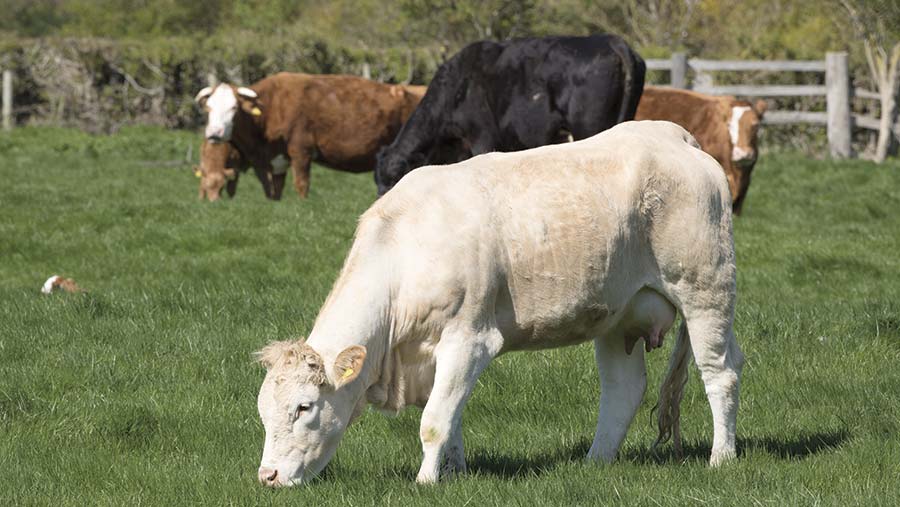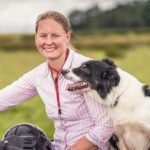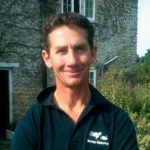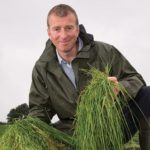Grass Watch: Slow growth but late spring in Northern Ireland
 © Tim Scrivener
© Tim Scrivener The increased rainfall since June made it tricky for our Scottish columnist to get silage in, but a late arrival of the sun meant they have got most of it done now.
And the all round drier summer reminded our Cheshire columnist of the value of reseeding – he has seen that his first and second-year leys have barely been affected by the dry spell at all.
Alice Muir, Buccleuch Estates, Scotland
- Land Langholm Farms: 7,085ha, mainly heather hill with 400ha of permanent grassland
- Stock 1,560 Blackface Ewes, 1,100 Scottish Country Cheviot ewes, 900 Greyface/Aberfield ewes and 50 Galloway Cows
- Altitude 80-404m

Alice Muir
We have had a lot of colder rainy days since June and, in comparison to last month, a lot of rainfall (last month was 63mm).
This means we have struggled to get silage done, but finally, the sun has arrived and we have managed to get most of the clipping done and most of the silage in as well.
In terms of grass growth, we started off the month really well, adding more ewes to the rotation to keep on top of the grass wedge.
But growth has suddenly slowed again and some of the fields are looking a bit yellow in places, largely due to the wet and slight poaching.
We are still ahead of the ewes in terms of grass in front of them, so hopefully, the grass will start growing again now the weather has warmed.
We are starting to think about weaning the lambs at the end of this month, which means we can bulk the ewes up and give the lambs the best fields, so this should help availability of grass in the future.
Some of the Aberfield and Cheviot mule lambs from the hill will also come down to the in-bye farm at this point so they can get better grazing post weaning.
The wet weather has also meant we are behind with sowing our grass fields, but everything is ploughed and ready to go so, hopefully, we will get our forage crops and grass seed sown this week and then we can focus on drawing fat lambs and weed wiping over the next month.
|
Cows or ewes per hectare |
Average 8.8/ha |
|
Growth rate (kg dm/ha) |
39 |
|
Average farm cover (kg DM/ha) |
1,850 |
|
Land type |
Peat/clay |
|
Average rainfall (mm/month) |
183 |
|
Figures correct to 13 July |
|
Richard Fryer, Northwich, Cheshire
- Land 127ha
- Stock 230 Friesian cows plus 120 youngstock
- Altitude 40m
- Calving Autumn block-calving, mainly grass based

Richard Fryer
Although it has been a dry summer so far, we do seem to get just enough rain to keep the grass growing.
Growth did slow to 50kg DM/ha in the first week of July but our demand is now falling as we dry more cows off each week.
If we ever needed convincing of the value of reseeding 10% of the grazing platform each year, this dry season is doing just that.
The first and second-year leys consistently grow back quicker than all the rest of the paddocks – they have hardly been affected by the lack of rain at all.
Without these, we would have been buffer feeding by now for sure.
The youngstock have enjoyed the summer so far, they have been very settled and are growing very well.
The first of the in-calf heifers are about to come back home for some milking parlour training, calving is just around the corner.
|
Stocking rate on grazing platform (cows a ha) |
4.8 |
|
Growth rate on platform (kg/day DM) |
80 |
|
Average farm cover (kg DM/ha) |
2,434 |
|
Yield (litres a cow a day) |
14 |
|
Fat (%) |
4.5 |
|
Protein (%) |
3.8 |
|
Milk solids (kg a cow) |
1.23 |
|
Supplements fed (kg a cow a day) |
1 |
|
Average rainfall (mm/day) |
15 (week ending 16 July) |
|
Land type |
Medium loam |
|
Figures correct to 16 July |
|
Mike Miller, Blandford, Dorset
- Land 106ha
- Stock 420 NZ Suffolk-cross Mules and 100 NZ Romney ewes
- Altitude 100m above sea level

Mike Miller
The normal seasonal dip in growth rates has duly occurred with some hot dry weather leaving open swards and grass heading.
Clover dominated swards give us our best chance of maintaining quality for the newly weaned lambs who are proving a challenge to keep behind wires, hopefully, they will settle down soon.
The ewes will be body condition scored, sorted into groups and allocated suitable grazing quality.
The plantain/clover covers are still performing really well despite the dry weather, although thistles are becoming an increasing problem and post-grazing topping is carried out to prevent them from seeding.
The swede crop is looking full of potential for a high winter yield and two foliar nutrient sprays have been applied to help it realise this.
See also: The 1,400 head dairy grazing year round
|
Cows or ewes a hectare |
1.1 livestock unit |
|
Growth rate (kg DM/ha) |
52 |
|
Average farm cover (kg DM/ha) |
2,150 |
|
Land type |
Heavy Clay |
|
Rainfall (mm) |
25 month to date |
|
Figures correct to 17 July |
|
Sam Chesney, Kircubbin, County Down
- Stock 150 Limousin sucklers
- Altitude 30m above sea level

Sam Chesney © Steffan Hill
Spring has sprung in July.
Yes, great grass growth similar to spring, with growth for the past four weeks at 97kg, 119kg, 42kg and 98kg respectively.
Along with 35.2 mm of rain so far this month, we, at last, have a comfortable wedge ahead of 14 days with a stocking of 3,000kg liveweight/ha.
Second cut has been well made and we are just about to mow red clover for the third time.
We’ve had plenty of good forage gathered in and great grass quality of grazed grass.
Taking a closer look at our paddocks performance it shows that some to date produced more than 10.5 t/ha, while a rented block has done slightly more than 4t/ha.
That makes the value of owned, well looked after ground, at this moment in time, more than 6t at £30/t, which is £180.
We are in a nitrate vulnerable zone and at present doing our half yearly check. It’s a shame my hands are tied due to nitrates yet production on this grass farm tells me the sky’s the limit
|
Growth rate (kg DM/ha) |
89/week |
|
Rainfall (mm) |
35.2 |
|
Land type |
Medium/heavy clay |
| Figures correct to 16 July | |
Robert Craig, Penrith, Cumbria
- Land Two Cumbrian dairy units – a 270ha at Dolphenby, near Penrith and 240ha at his home farm in Cairnhead
- Stock 550 cows at Dolphenby and 460 at Cairnhead. Both herds are New Zealand/Kiwi-cross cows
- Altitude Ranges from 160-210m above sea level
- Calving Spring calving

Robert Craig © John Eveson
Normal service seems to have resumed following reasonable rainfall towards the end of June and into the beginning of July, which was also followed by some decent sunlight.
With daylight hours reducing, grass is less prone to seeding and with growth heading towards 100kg DM/ha/day, quality looks to be good.
Milk solids are running slightly ahead of 2016, mostly due to a slight increase in yield from a more mature herd.
Based on 2016, we need to grow an average of 70kg DM/ha/day until the end of August to produce a similar amount of grass, but with silage provision looking tight, ideally, we could do with more.
We’ll have a better idea of silage stocks in a couple of days as we’re cutting again as I type.
Almost all of the 2017 heifer calves are now on a grass only diet with just a few of the lighter calves still receiving concentrates until they catch up.
|
Stocking rate on grazing platform (cows a ha) |
4.01 |
|
Growth rate on platform (kg DM/day) |
87 (12 July) |
|
Average farm cover (kg DM/ha) |
2,227 (12 July) |
|
Yield (litres a cow a day) |
23 |
|
Fat (%) |
4.3 |
|
Protein (%) |
3.5 |
|
Milk solids (kg/cow) |
1.8 |
|
Supplements fed (kg a cow a day) |
4 |
|
Average rainfall (mm/day) |
(146 – June) 140 – 17 July |
|
Land type |
Free-draining sandy loam |
|
Figures correct to 17 July |
|
Ben Richards, Helston, Cornwall
- Land 146ha
- Stock 280 Jersey-cross Friesians
- Altitude 110m above sea level
- Calving Spring-calving

Ben Richards
Two weeks of hot dry weather slowed growth and reduced average farm cover by another 150kgs DM/ha back to 2,150.
I applied urea and it rained the next day.
I have been on a fast round (16-19 days) and need to extend that to 24-26 days going into the summer.
I am trying to use fertiliser as a tool to plug feed deficits and get away from ritual nitrogen spreading, although the recent price drop has made nitrogen use a bit more profitable.
My trial zero-nitrogen paddock is now growing more (+15 day) than the adjacent paddock which has had fertiliser, but it grew an average of 30kg/day less up to the end of June.
The cows are flatlining at the moment, which I find is quite normal for once a day milked herds.
I would expect them to hold at 1.5kg milk solid a cow through to mid-August.
The calves are now grazing herbal leys and looking very well.
They are the first batch of animals I have reared with zero concentrates. I am extremely pleased with the results and I get to save some cash – happy days.
|
Stocking rate on grazing platform (cows a ha) |
2.9 |
|
Growth rate on platform (kg/day DM) |
76 |
|
Average farm cover (kg/ha DM) |
2,600 |
|
Yield (litres a cow a day) |
14 |
|
Protein (%) |
4.1 |
|
Fat (%) |
5.2 |
|
Milk solids (kg a cow) |
1.5 |
|
Supplements fed (kg a cow a day) |
0 |
|
Rainfall (mm) |
89 |
|
Land type |
Free-draining sandy loam |
| Figures correct to 18 July | |
Gareth Davies, independent grassland expert
Feed of the Future?
No one needs reminding we live in very uncertain times, the industry is learning to adapt to continual milk price volatility both nationally and internationally, and there is the huge uncertainty of Brexit, on one side it could bring great opportunities but on the other side, it could bring huge pressure to the industry.
From conversations, I have had, and experts I have listened to, the only conclusion I can come to is the fact no one has the faintest idea what is going to happen.
So with this in mind, I think most UK livestock farmers need to focus on one thing, and that is their cost of production, if farmers can make their businesses as streamlined and as efficient as possible, this will put them in as good a position as possible to deal with all of the aforementioned uncertainty.
This is where my beloved green stuff comes in to play, with quality grass being the cheapest feed option, it makes perfect sense to spend time improving grassland management skills and improving farm infrastructure.
I think that because grazing management isn’t particularly exciting it tends to get overlooked, yet as soon as milk and lamb prices tumble my phone is busier than ever.
So farmers, deep down, know grass can play a significant role in their cost of production. So the answer to my question yes grass is a feed of the future.
